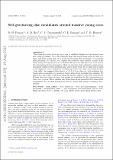Files in this item
Self-gravitating disc candidates around massive young stars
Item metadata
| dc.contributor.author | Forgan, D. H. | |
| dc.contributor.author | Ilee, J. D. | |
| dc.contributor.author | Cyganowski, C. J. | |
| dc.contributor.author | Brogan, C. L. | |
| dc.contributor.author | Hunter, T. R. | |
| dc.date.accessioned | 2016-10-11T11:30:20Z | |
| dc.date.available | 2016-10-11T11:30:20Z | |
| dc.date.issued | 2016-11-21 | |
| dc.identifier | 246547238 | |
| dc.identifier | 203d002b-8c1a-474c-b1ff-445df4287dc8 | |
| dc.identifier | 000386464900076 | |
| dc.identifier | 85014357866 | |
| dc.identifier.citation | Forgan , D H , Ilee , J D , Cyganowski , C J , Brogan , C L & Hunter , T R 2016 , ' Self-gravitating disc candidates around massive young stars ' , Monthly Notices of the Royal Astronomical Society , vol. 463 , no. 1 , pp. 957-964 . https://doi.org/10.1093/mnras/stw1917 | en |
| dc.identifier.issn | 1365-2966 | |
| dc.identifier.other | ArXiv: http://arxiv.org/abs/1608.05539v1 | |
| dc.identifier.uri | https://hdl.handle.net/10023/9642 | |
| dc.description | DHF gratefully acknowledges support from the ECOGAL project, grant agreement 291227, funded by the European Research Council under ERC-2011-ADG. JDI gratefully acknowledges support from the DISCSIM project, grant agreement 341137, funded by the European Research Council under ERC-2013-ADG. CJC acknowledges support from STFC grant ST/M001296/1. | en |
| dc.description.abstract | There have been several recent detections of candidate Keplerian discs around massive young protostars. Given the relatively large disc-to-star mass ratios in these systems, and their young ages, it is worth investigating their propensity to becoming self-gravitating. To this end, we compute self-consistent, semi-analytic models of putative self-gravitating discs for five candidate disc systems. Our aim is not to fit exactly the observations, but to demonstrate that the expected dust continuum emission from marginally unstable self-gravitating discs can be quite weak, due to high optical depth at the mid-plane even at millimetre wavelengths. In the best cases, the models produce ‘observable’ disc masses within a factor of <1.5 of those observed, with mid-plane dust temperatures comparable to measured temperatures from molecular line emission. We find in two cases that a self-gravitating disc model compares well with observations. If these discs are self-gravitating, they satisfy the conditions for disc fragmentation in their outer regions. These systems may hence have as-yet-unresolved low-mass stellar companions, and are thus promising targets for future high angular resolution observations. | |
| dc.format.extent | 2491044 | |
| dc.language.iso | eng | |
| dc.relation.ispartof | Monthly Notices of the Royal Astronomical Society | en |
| dc.subject | Stars: formation | en |
| dc.subject | Stars: massive | en |
| dc.subject | Stars: pre-main sequence | en |
| dc.subject | Stars: protostars | en |
| dc.subject | Radio continuum: stars | en |
| dc.subject | Submillimetre: stars | en |
| dc.subject | QB Astronomy | en |
| dc.subject | QC Physics | en |
| dc.subject | T-NDAS | en |
| dc.subject.lcc | QB | en |
| dc.subject.lcc | QC | en |
| dc.title | Self-gravitating disc candidates around massive young stars | en |
| dc.type | Journal article | en |
| dc.contributor.sponsor | Science & Technology Facilities Council | en |
| dc.contributor.institution | University of St Andrews. School of Physics and Astronomy | en |
| dc.contributor.institution | University of St Andrews. St Andrews Centre for Exoplanet Science | en |
| dc.identifier.doi | 10.1093/mnras/stw1917 | |
| dc.description.status | Peer reviewed | en |
| dc.identifier.grantnumber | ST/M001296/1 | en |
This item appears in the following Collection(s)
Items in the St Andrews Research Repository are protected by copyright, with all rights reserved, unless otherwise indicated.

